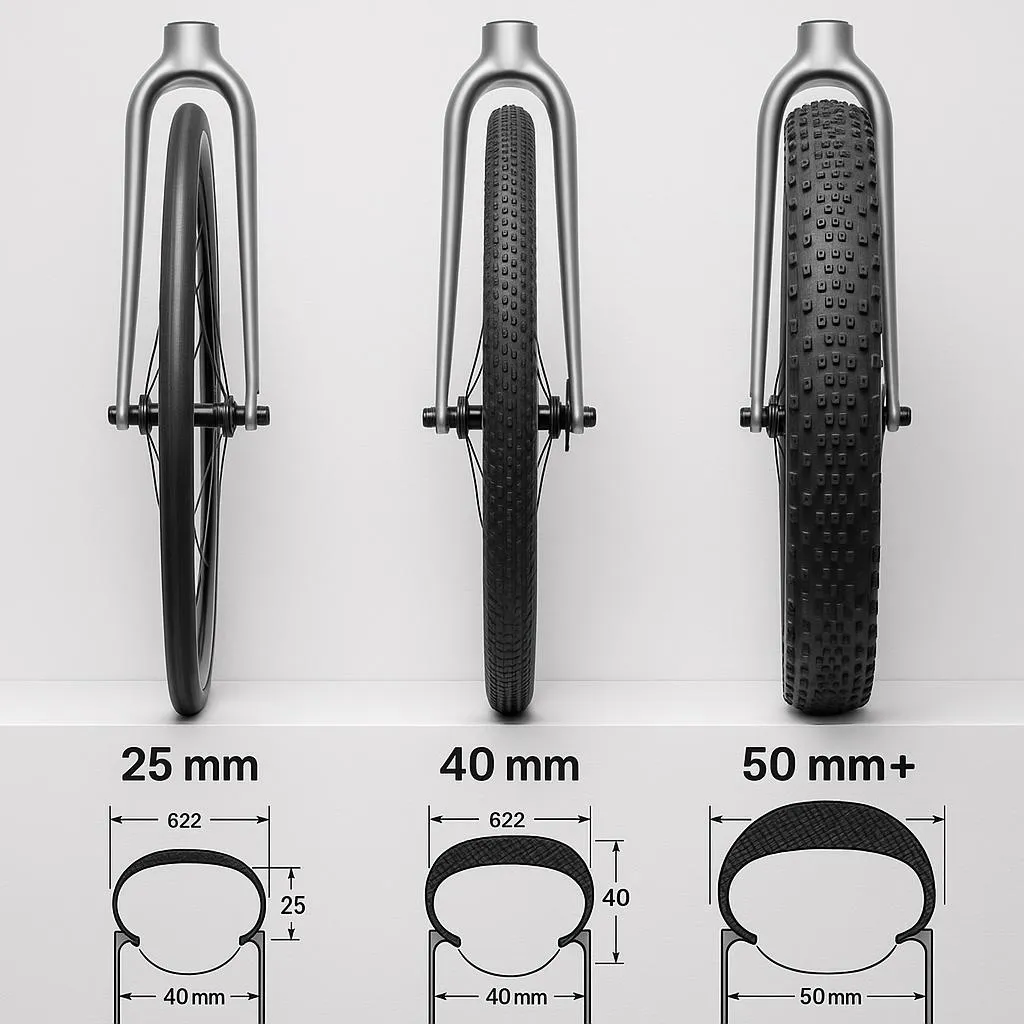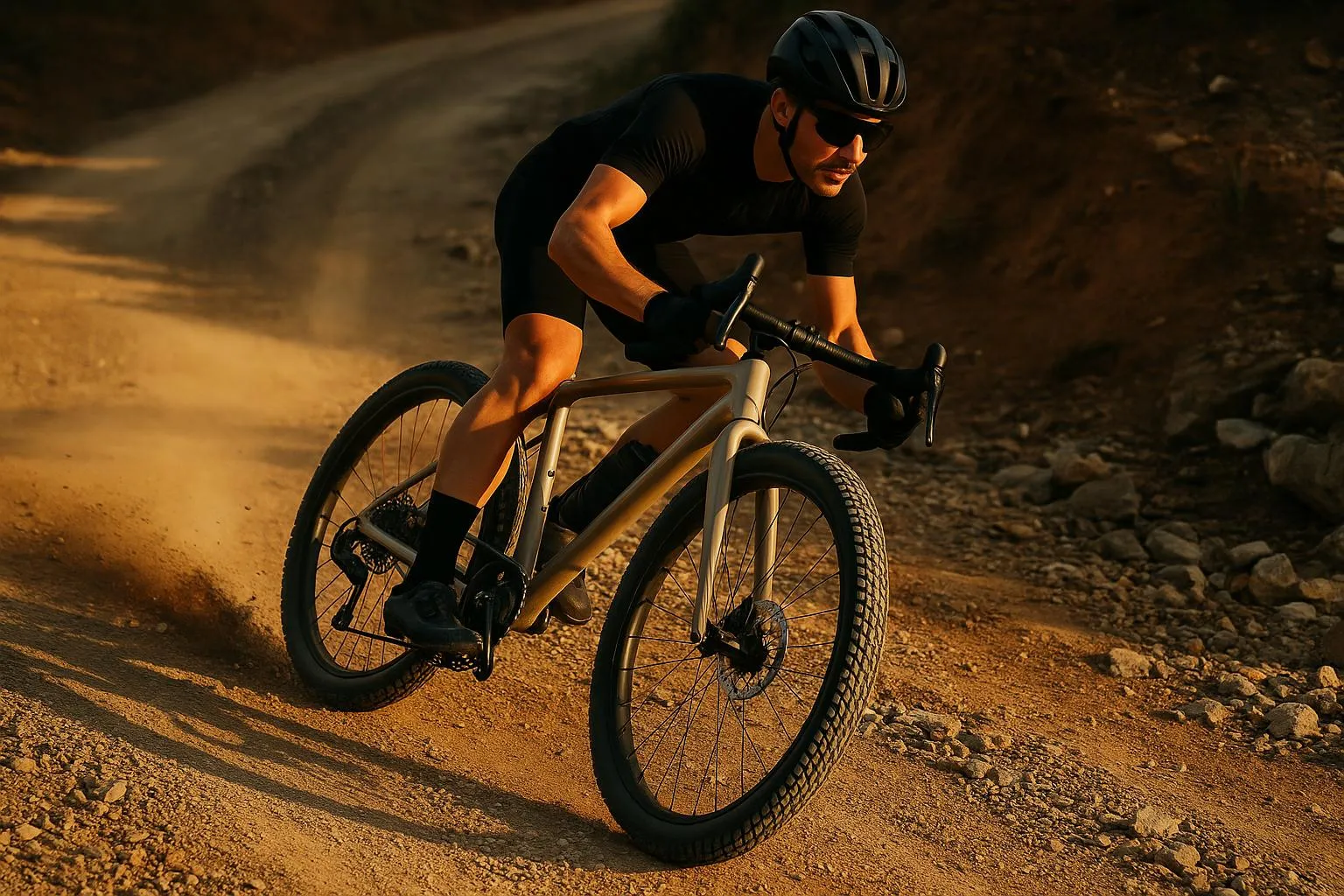The gravel cycling world is experiencing a fundamental transformation in 2025, with wider tire technology emerging as the defining trend that’s reshaping how cyclists approach adventure riding, bikepacking, and off-road exploration. This revolution extends far beyond simple equipment preferences, representing a paradigm shift in cycling philosophy that prioritizes comfort, capability, and versatility over traditional notions of speed and efficiency.
The movement toward wider tires in gravel cycling reflects a deeper understanding of how tire technology impacts the overall riding experience. As cyclists increasingly seek adventures that take them beyond paved roads and into diverse terrain, the limitations of narrow tire setups have become apparent. The wider tire revolution addresses these limitations while opening new possibilities for exploration and adventure that were previously challenging or impossible.
This transformation is being driven by advances in tire technology, frame design, and a growing body of research that challenges long-held assumptions about rolling resistance and performance. The result is a new generation of gravel bikes and tire systems that offer unprecedented capability and comfort for riders seeking to push the boundaries of where their bikes can take them.

The Science Behind Wider Tire Performance
The physics of wider tire performance in gravel cycling applications reveals why this technology represents such a significant advancement. Traditional cycling wisdom suggested that narrower tires were inherently faster due to reduced rolling resistance, but modern research and real-world testing have revealed a more complex relationship between tire width, pressure, and performance across different surfaces.
Wider tires allow for significantly lower air pressures while maintaining structural integrity and performance characteristics. This lower pressure capability provides several key advantages that are particularly relevant for gravel and adventure cycling applications. The increased tire contact patch distributes rider weight more evenly across the tire surface, reducing pressure per square inch on the ground and improving traction on loose or uneven surfaces.
The relationship between tire pressure and rolling resistance is particularly important in gravel cycling contexts. While higher pressures may provide lower rolling resistance on smooth pavement, the opposite is often true on rough or unpaved surfaces. Lower pressures allow the tire to conform to surface irregularities rather than bouncing over them, maintaining better contact with the ground and actually reducing energy loss through vibration and impact.
The comfort benefits of wider tires operating at lower pressures extend beyond simple rider comfort to impact performance and endurance. Reduced vibration transmission through the bike frame and into the rider’s body decreases fatigue and allows for longer, more enjoyable rides. This comfort advantage becomes increasingly important on longer adventures where rider fatigue can significantly impact performance and safety.
Modern tire construction techniques have also evolved to support wider tire designs without the weight penalties that were once associated with larger tire volumes. Advanced casing materials, optimized tread patterns, and improved manufacturing processes have enabled the development of wide tires that are often lighter than their narrower counterparts while providing superior performance characteristics.
Current Market Trends and Adoption Patterns
The gravel cycling market has shown remarkable growth and evolution in 2025, with wider tire adoption representing one of the most significant trends driving this expansion. Market data indicates that gravel bike sales have maintained consistent growth of 14% over the past six and twelve months, with much of this growth attributed to bikes designed around wider tire clearances and capabilities [1].
Professional gravel racing has become a key driver of wider tire adoption, with race analysis revealing that most competitive riders are now using tires sized 45mm and larger. This professional adoption has created a trickle-down effect that influences recreational rider choices and manufacturer design decisions. The performance advantages demonstrated in competitive settings provide compelling evidence for the benefits of wider tire technology.
Manufacturer response to this trend has been swift and comprehensive, with major bike brands redesigning their gravel platforms to accommodate increasingly wide tire options. Many flagship gravel bikes now come standard with 50mm tires and have clearance for even wider options. Some models can accommodate 29 x 2.0″ mountain bike tires, blurring the traditional boundaries between gravel bikes and mountain bikes.
The tire industry has responded to this demand with an expanded range of gravel-specific tire options in wider sizes. Interestingly, some high-end mountain bike tires in wider sizes are actually lighter than their gravel-specific counterparts, creating new opportunities for performance optimization. For example, the Pirelli Scorpion XC RC in a 29 x 2.2″ size weighs 610g compared to the Cinturato M in a 50mm size at 705g [1].
Consumer adoption patterns show increasing acceptance of wider tire setups across all levels of gravel cycling participation. Entry-level riders are discovering that wider tires make gravel cycling more accessible and enjoyable, while experienced riders are finding that wider setups enable more ambitious adventures and challenging terrain exploration.
Equipment Evolution and Frame Design
The evolution toward wider tire compatibility has necessitated significant changes in gravel bike frame design and geometry. Modern gravel frames must accommodate not only wider tires but also the increased clearance requirements for mud, debris, and tire flex that come with lower pressure operation.
Frame designers have had to reconsider traditional geometry assumptions to optimize bikes for wider tire performance. The increased tire volume and different handling characteristics of wider setups require adjustments to head tube angles, bottom bracket heights, and wheelbase measurements to maintain optimal handling and stability.
Brake system design has also evolved to support wider tire applications. Disc brake systems have become virtually universal in gravel cycling, providing the clearance and stopping power necessary for wider tire setups. The increased tire volume and lower pressures associated with wider tires also impact braking performance, requiring consideration of brake modulation and heat dissipation characteristics.
Wheel design has undergone significant evolution to support wider tire applications effectively. Rim widths have increased to provide optimal tire profile support for wider tires, with many gravel-specific wheels now featuring internal rim widths of 25mm or more. This wider rim profile helps maintain tire shape and performance characteristics when running lower pressures.
The integration of wider tire capability with other bike systems has required careful consideration of component compatibility and performance optimization. Drivetrain clearance, fender mounting options, and accessory attachment points must all be designed to work effectively with wider tire setups and the frame modifications they require.
Performance Benefits Across Different Terrain Types
The performance advantages of wider tire setups vary significantly across different terrain types, with the benefits becoming more pronounced as surface conditions become more challenging. Understanding these performance characteristics helps riders optimize their tire choices for specific riding conditions and adventure goals.
On hardpack gravel and smooth dirt roads, wider tires operating at appropriate pressures can match or exceed the performance of narrower setups while providing superior comfort and control. The ability to run lower pressures without risking pinch flats or rim damage allows riders to optimize their setup for the specific surface conditions they encounter.
Loose gravel and sandy conditions represent where wider tires show their most dramatic performance advantages. The increased contact patch and ability to run very low pressures provide significantly improved traction and control in these challenging conditions. Riders report being able to maintain speed and control in conditions that would be difficult or dangerous with narrower tire setups.
Technical terrain including rocks, roots, and mixed surfaces benefits enormously from wider tire technology. The increased tire volume provides better impact absorption and puncture resistance, while the improved traction characteristics enable riders to tackle more challenging lines and obstacles with confidence.
Wet and muddy conditions present unique challenges where wider tire performance depends heavily on tread pattern design and tire construction. While wider tires can provide better flotation in soft conditions, they may also collect more mud in certain situations. Modern tire designs address these challenges with optimized tread patterns and mud-shedding technologies.
The versatility of wider tire setups enables riders to tackle more diverse terrain within a single ride or adventure. This capability expansion has opened new possibilities for route planning and exploration, allowing riders to include terrain that would previously have required different equipment or been avoided entirely.
Integration with Adventure and Bikepacking Applications
The wider tire revolution has had a particularly significant impact on adventure cycling and bikepacking applications, where the combination of comfort, capability, and reliability is paramount. The ability to carry gear while maintaining control and comfort over diverse terrain has made wider tire setups virtually essential for serious bikepacking adventures.
Load carrying considerations become increasingly important when evaluating tire performance for bikepacking applications. Wider tires provide better stability and control when carrying heavy loads, while the improved puncture resistance and durability characteristics reduce the risk of mechanical issues in remote locations. The comfort benefits of wider tires become even more critical when riding loaded bikes over long distances and challenging terrain.
The integration of wider tire technology with bikepacking revolution equipment and techniques has enabled more ambitious adventures and opened previously inaccessible destinations to bicycle exploration. Riders can now tackle routes that combine pavement, gravel, singletrack, and technical terrain within a single adventure, expanding the possibilities for multi-day cycling exploration.
Route planning for bikepacking adventures has been transformed by the capabilities that wider tire setups provide. Riders can now consider routes that include more diverse terrain types and challenging conditions, knowing that their equipment can handle the demands. This capability expansion has led to the development of new bikepacking routes and destinations that take advantage of wider tire performance characteristics.
The reliability and durability advantages of wider tire setups are particularly important for self-supported adventures where mechanical issues can have serious consequences. The reduced risk of punctures, improved impact resistance, and better overall durability of wider tire systems provide important safety margins for remote adventures.
Comparison with Traditional Cycling Approaches
The shift toward wider tires in gravel cycling represents a fundamental departure from traditional road cycling approaches and philosophies. Understanding these differences helps illustrate why wider tire technology has become so transformative for adventure cycling applications.
Traditional road cycling has historically prioritized aerodynamic efficiency and rolling resistance minimization, leading to the adoption of narrow, high-pressure tire setups. While these characteristics remain important for certain types of cycling, they become less relevant or even counterproductive in gravel and adventure cycling contexts where comfort, control, and capability take precedence.
The weight considerations that have traditionally favored narrower tire setups have been largely negated by advances in tire construction and materials technology. Modern wide tires can match or beat the weight of traditional narrow setups while providing superior performance characteristics for gravel applications. This weight parity removes one of the primary arguments against wider tire adoption.
Rolling resistance comparisons between wide and narrow tire setups reveal a complex relationship that depends heavily on surface conditions and riding style. While narrow tires may have advantages on smooth pavement, wider tires often perform better on the rough and varied surfaces that characterize gravel cycling. The ability to optimize pressure for specific conditions gives wider tire setups a significant advantage in real-world gravel riding scenarios.
The handling and control characteristics of wider tire setups differ significantly from traditional narrow tire approaches. Wider tires provide more predictable handling, better cornering grip, and improved stability, particularly in challenging conditions. These characteristics are particularly valuable for less experienced riders or those tackling unfamiliar terrain.
The maintenance and durability advantages of wider tire setups represent another significant departure from traditional cycling approaches. The reduced risk of punctures, improved impact resistance, and longer tire life associated with wider setups can significantly reduce maintenance requirements and costs over time.
Technical Considerations and Setup Optimization
Optimizing wider tire setups for gravel cycling requires understanding the complex relationships between tire pressure, rim width, tire construction, and riding conditions. Getting these relationships right is essential for realizing the full performance potential of wider tire technology.
Tire pressure optimization represents one of the most critical aspects of wider tire setup. The ability to run significantly lower pressures is one of the primary advantages of wider tires, but finding the optimal pressure requires consideration of rider weight, riding style, terrain conditions, and tire construction characteristics. Many riders find that optimal pressures for wider gravel tires are 20-30% lower than they might expect based on traditional cycling experience.
Rim width compatibility plays a crucial role in wider tire performance and safety. Modern gravel wheels are designed with wider internal rim widths to support wider tires effectively, but compatibility between specific tire and rim combinations should be verified to ensure optimal performance and safety. The relationship between rim width and tire width affects tire profile, handling characteristics, and pressure requirements.
Tire construction considerations become increasingly important with wider tire setups. Different casing materials, bead types, and construction techniques can significantly impact performance, durability, and ride characteristics. Understanding these differences helps riders select tires that match their specific needs and riding style.
Tubeless tire setup has become increasingly popular with wider tire applications, offering advantages in puncture resistance, pressure optimization, and overall performance. However, tubeless setup requires specific techniques and considerations that differ from traditional tube-based systems. Proper tubeless setup is essential for realizing the full benefits of wider tire technology.
The integration of wider tire setups with other bike systems requires careful consideration of clearances, compatibility, and performance optimization. Brake adjustment, drivetrain clearance, and accessory mounting may all require modification when transitioning to wider tire setups.




